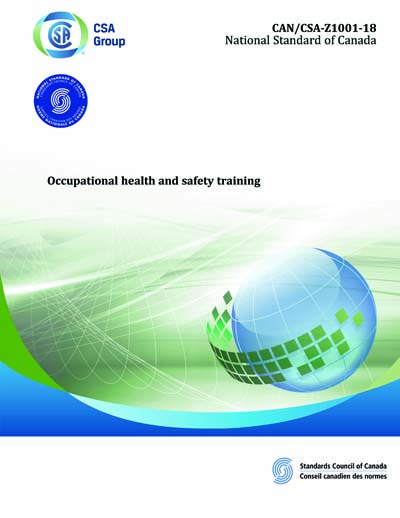Most recent
CAN/CSA Z1001-2018
Occupational health and safety training
Preface
This is the second edition of CAN/CSA-Z1001, Occupational health and safety training. It supersedes the previous edition published in 2013. This Standard addresses the needs of an organization to provide consistent quality occupational health and safety (OHS) training for workers, managers, and supervisors, as well as for health and safety committees and representatives. Changes in this edition include a) the addition of Annex A on adult education principles; b) the addition of Annex B on training needs assessment; c) the addition of Annex G on sample training provider evaluation form; d) the addition of Annex H on guidance on planning for high-risk training; and e) the addition of Annex J on training course conformance checklist. This Standard is now referenced in many other CSA Group OHS training standards and training elements in other CSA Group standards. ANSI/ASSE Z490.1, Criteria for Accepted Practices in Safety, Health, and Environmental Training, was used as the seed document for the preparation of this Standard, with permission of the American Society of Safety Engineers (ASSE). CSA Group acknowledges that the development of this Standard was made possible, in part, by the financial support of federal, provincial, and territorial OHS government agencies.Scope
1.1 Scope This Standard specifies requirements for management and administration of OHS training, identification of OHS training needs, and outlines the development, implementation, and maintenance of an OHS training program and courses. It also specifies how to select training providers with the appropriate qualifications and the requirements for the design and delivery of OHS training courses. Informative Annexes provide guidance on how to implement the requirements of this Standard, it includes information on adult education principles (see Annex A), training for new workers (see Annex C), training for supervisors (see Annex D), training for health and safety committees and health and safety representatives (see Annex F). It also provides guidance on high-risk training (see Annex H). Samples of a training needs assessment (see Annex B), supervisor training matrix (see Annex E), training provider evaluation (see Annex G), trainee evaluation forms (Annex I) and training course conformance checklist (see Annex J) are also included that can be customized for the specific needs of the user. 1.2 Purpose The purpose of this Standard is to provide requirements and guidance to organizations and training providers on accepted practices for OHS training. 1.3 Exclusions This Standard is focused on formal training, which includes some form of formal evaluation in order to measure the learning achieved. Therefore, this Standard specifically excludes instructional activities delivered outside a formal training program that do not include formal evaluation of the learning through testing or other formalized methods. This exclusion covers instruction that can be delivered by a trained or untrained educator, as well as toolbox talks, tailgate talks, informal on-the-job training, or other forms of delivery that do not include a formal evaluation of the learning through testing or other evaluation methods. This Standard is not restricted to particular training delivery methods. The principles and requirements specified in this Standard apply to any type of training service or product (e.g., theoretical, practical, class-room, in-the-field, on-the-job, on-line, etc.). Notes: 1) Training is defined in Clause 3 of this Standard and requirements are specified in Clauses 4 to 7. 2) See Clause 6.4.3 for an explanation about the activities excluded. 1.4 Application This Standard is applicable to organizations of any size or type that have workers and to organizations and individuals who design, develop, and/or deliver OHS training products and/or services. 1.5 Relationship to legal requirements At the time of publication of this Standard, legal requirements respecting OHS training differed from jurisdiction to jurisdiction in Canada. It is the user's responsibility to determine how applicable legislative requirements relate to this Standard. 1.6 Terminology In this Standard, shall is used to express a requirement, i.e., a provision that the user is obliged to satisfy in order to comply with the standard; should is used to express a recommendation or that which is advised but not required; may is used to express an option or that which is permissible within the limits of the standard; and can is used to express possibility or capability. Notes accompanying clauses do not include requirements or alternative requirements; the purpose of a note accompanying a clause is to separate from the text explanatory or informative material. Notes to tables and figures are considered part of the table or figure and may be written as requirements. Annexes are designated normative (mandatory) or informative (non-mandatory) to define their application.CSA America, Inc. [csa]

